1976 CHEVROLET VEGA air condition
[x] Cancel search: air conditionPage 36 of 87
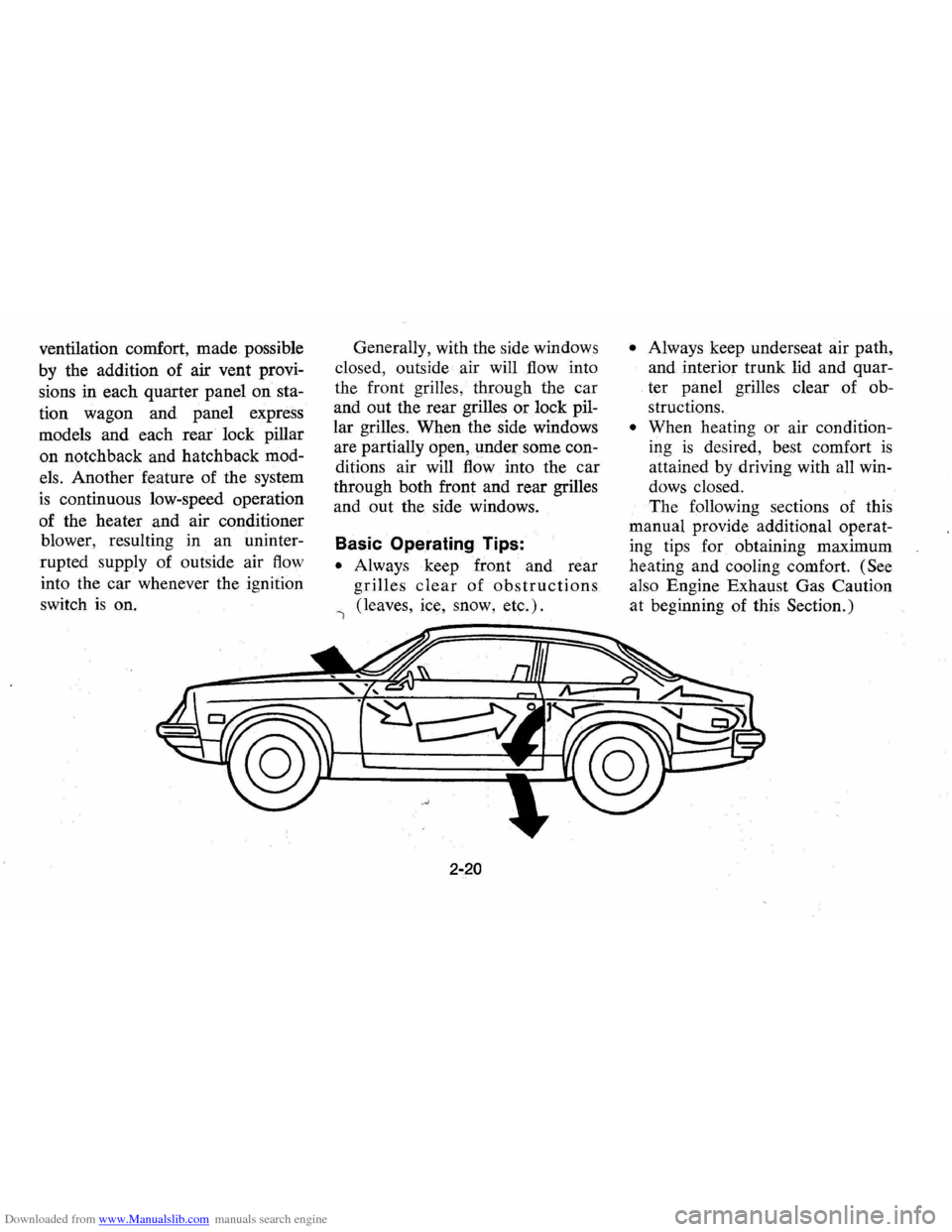
Downloaded from www.Manualslib.com manuals search engine ventilation comfort, made possible
by the addition of air vent provi
sions in each quarter panel on sta
tion wagon and panel express
models and each rear lock pillar
on notchback and hatchback mod
els. Another feature of the system
is continuous low-speed operation
of the heater and air conditioner
blower, resulting in an uninter
rupted supply of outside air
flow
into the car whenever the ignition
switch
is on. Generally,
with the side windows
closed, outside· air will
flow into
the front grilles, through the car
and out the rear grilles
or lock pil
lar grilles. When the side windows
are partially open, under some con
ditions air will
flow into the car
through both front and rear grilles
and out the side windows.
Basic Operating Tips:
• Always keep front and rear
grilles clear of obstructions
, (leaves, ice, snow, etc.).
2-20
• Always keep underseat air path,
and interior trunk lid and quar
ter panel grilles clear of ob
structions.
• When heating or air condition
ing
is desired, best comfort is
attained by driving with all win
dows closed.
The following sections of this
manual provide additional operat
ing tips for obtaining maximum
heating and cooling comfort.
(See
also Engine Exhaust Gas Caution
at beginning of this Section.)
Page 37 of 87
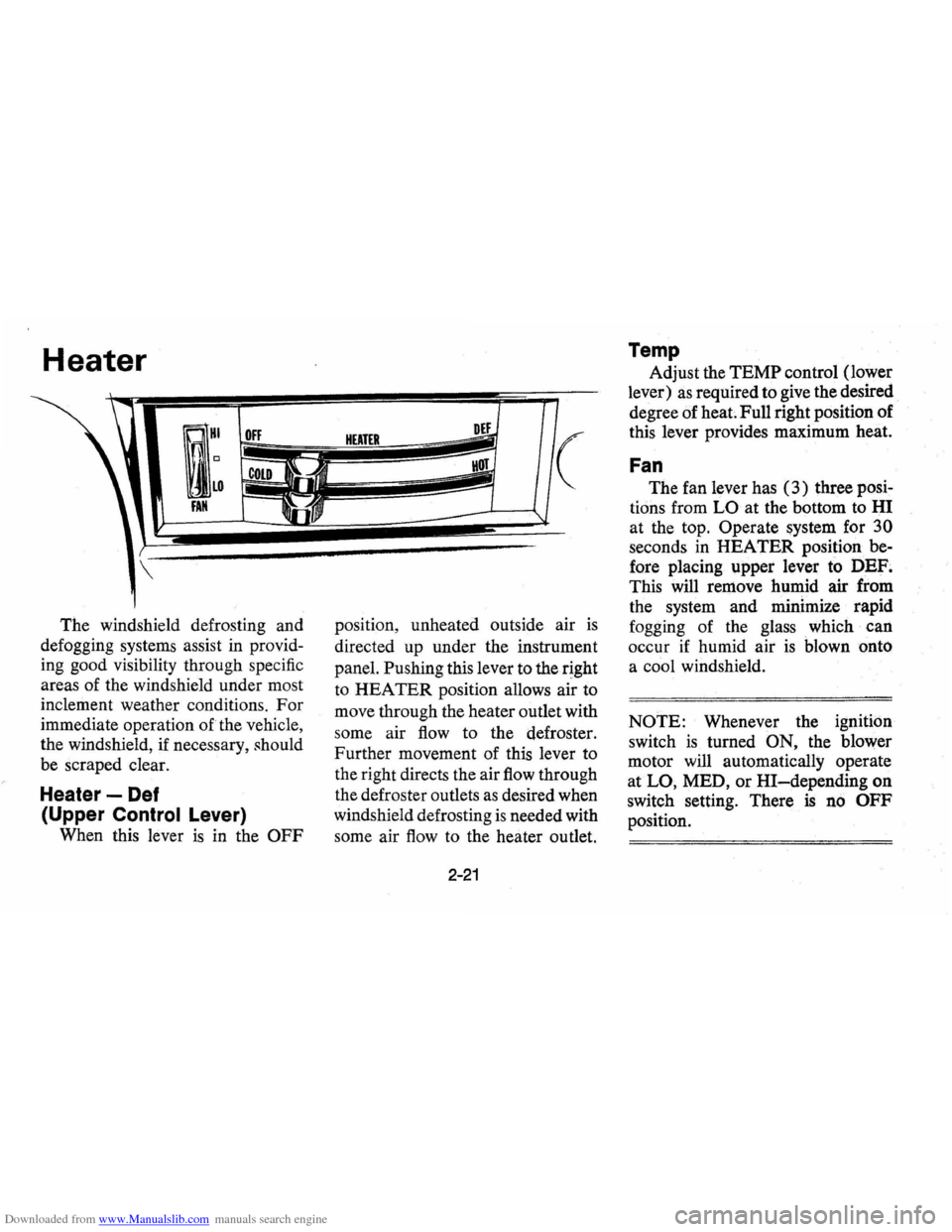
Downloaded from www.Manualslib.com manuals search engine Heater
RHI
I~
OFF
COLD
FAN
The windshield defrosting and
defogging systems assist
in provid
ing good visibility through specific
areas of the windshield under most
inclement weather conditions. For
immediate operation of the vehicle,
the windshield,
if necessary, should
be scraped clear.
Heater -Def
(Upper Control Lever)
When this lever is in the OFF
HEATER
(
posItion, unheated outside air is
directed up under the instrument
panel.
Pushing this lever to the r!ght
to HEATER position allows air to
move through the heater outlet with
some air
flow to the defroster.
Further movement of this lever to
the right directs the air
flow through
the defroster outlets
as desired when
windshield defrosting
is needed with
some air
flow to the heater outlet.
2-21
Temp
Adjust the TEMP control (lower
lever)
as required to give the desired
degree of
heat Full right position of
this lever provides maximum heat.
Fan
The fan lever has (3) three posi
tions from
LO at the bottom to HI
at the top. Operate system for
30
seconds in HEATER position be
fore placing upper lever
to DEF;
This will remove humid air from
the system
and minimize rapid
fogging of the glass which can
occur
if humid air is blown onto
a cool windshield.
NOTE: Whenever the ignition
switch
is turned ON, the blower
motor
will automatically operate
at
LO, MED, or HI-depending on
switch setting. There
is no OFF
position.
Page 39 of 87
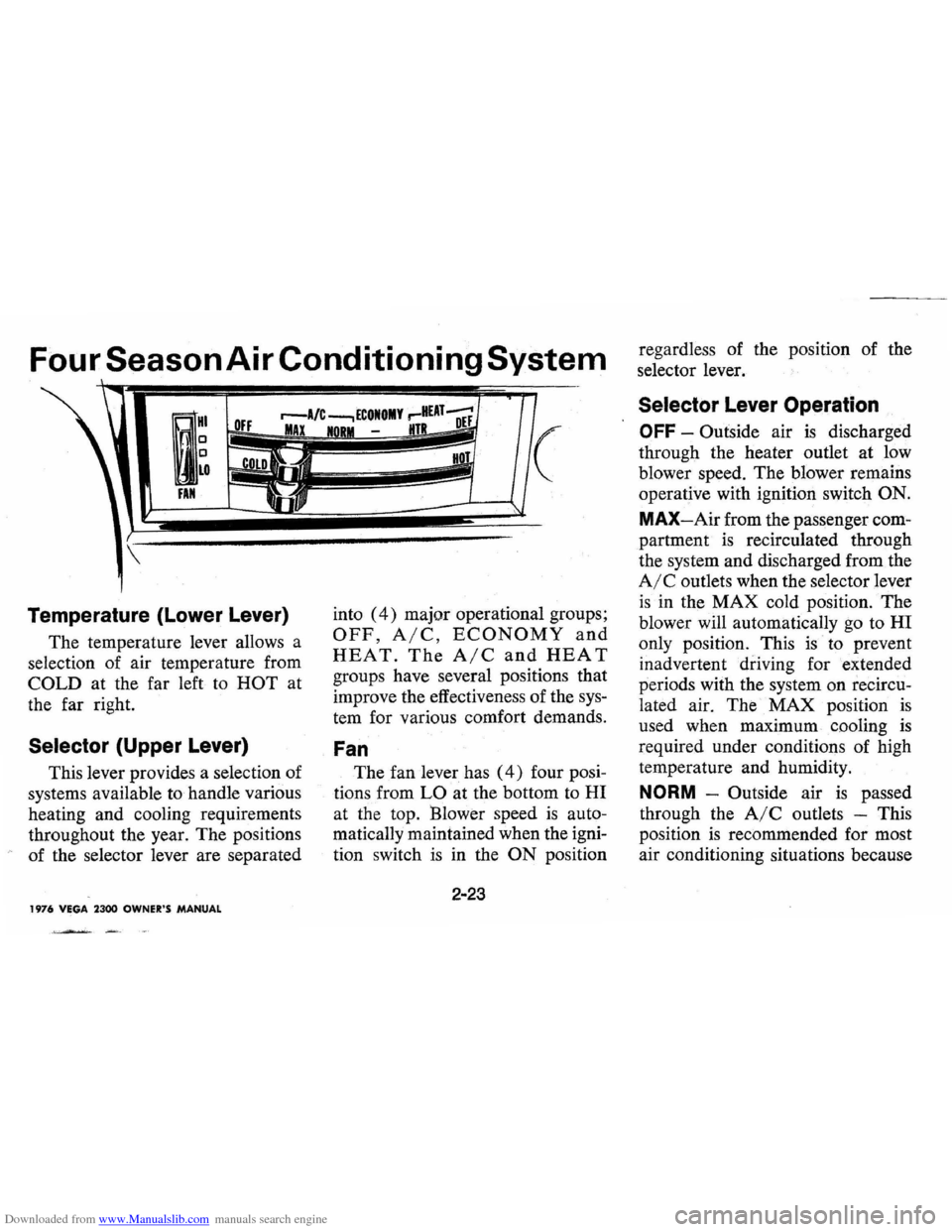
Downloaded from www.Manualslib.com manuals search engine Four Season Air Conditioning System
g
HI OFF r--A/C ---. ECOIIOMY ,-HUT D'Ef MAX -HT
(
. 0 o
LO
nil
Temperature (Lower Lever)
The temperature lever allows a
selection of air temperature from
COLD at the far left to HOT at
the far right.
Selector (Upper Lever)
This lever provides a selection of
systems available to handle various
heating and cooling requirements
throughout the year. The positions
of the selector lever are separated
1976 VEGA 2300 OWNER'S MANUAL
.. ~ -..-~.
into (4) major operational groups;
OFF, AIC, ECONOMY and
HEAT. The AIC and HEA T
groups have several positions that
improve the effectiveness of the
sys
tem for various comfort demands.
Fan
The fan lever has (4) four posi
tions from
LO at the bottom to HI
at the top. Blower speed is auto
matically maintained when the igni
tion switch
is in the ON position
2-23
regardless of the position of the
selector lever.
Selector Lever Operation
OFF -Outside air is discharged
through the heater outlet at low
blower speed. The blower remains
operative with ignition switch
ON.
MAX-Air from the passenger com
partment
is recirculated through
the system and discharged from the
AIC outlets when the selector lever
is in the MAX cold position. The
blower will automatically go to
HI
only position. This is' to prevent
inadvertent driving for extended
periods with the system on recircu
lated air. The MAX position
is
used when maximum cooling is
req uired under conditions of high
temperature and humidity.
NORM -Outside air is passed
through the
AIC outlets -This
position
is recommended for most
air conditioning situations because
Page 40 of 87
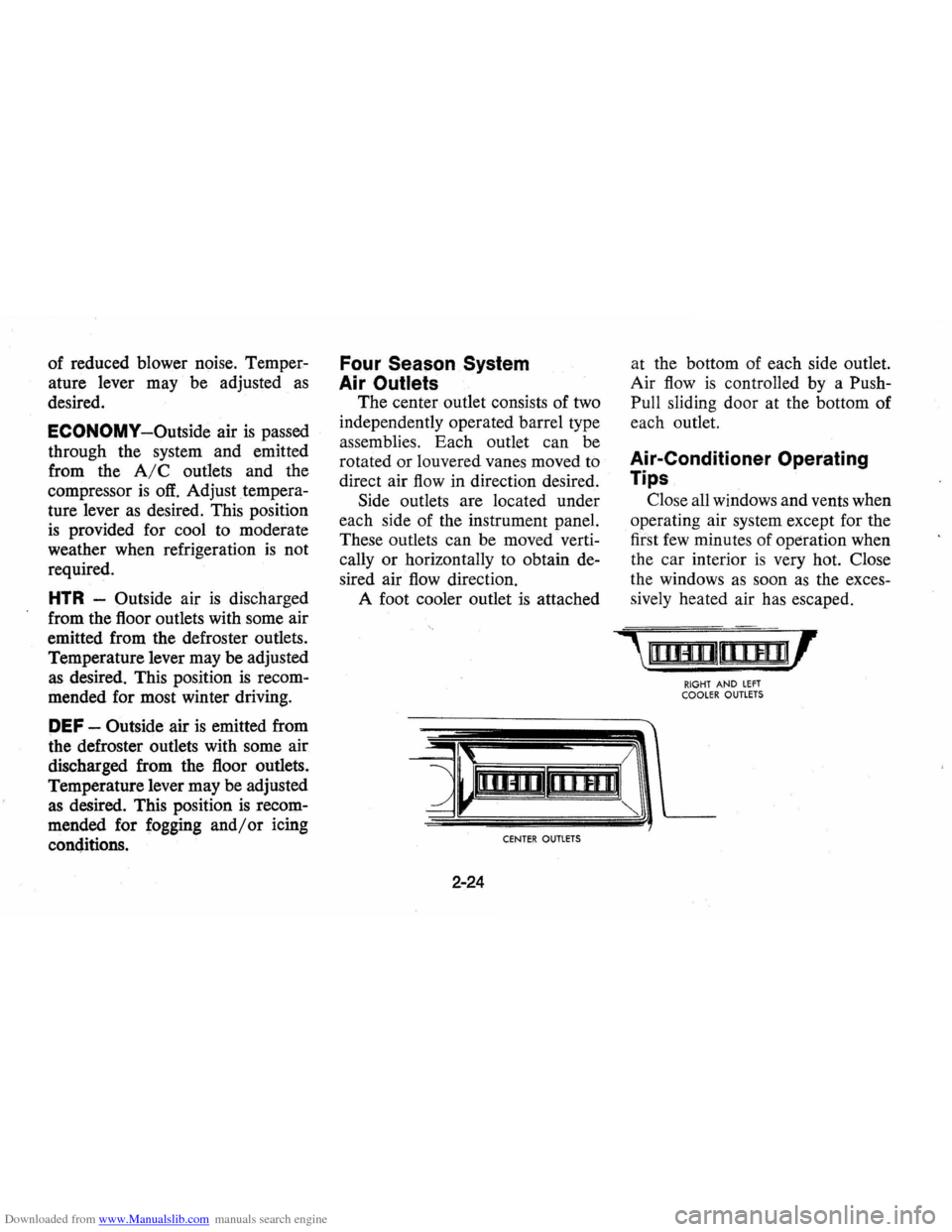
Downloaded from www.Manualslib.com manuals search engine of reduced blower noise. Temper
ature lever may be adjusted
as
desired.
ECONOMY-Outside air is passed
through the system and emitted
from the
A/C outlets and the
compressor
is off. Adjust tempera
ture lever
as desired. This position
is provided for cool to moderate
weather when refrigeration
is not
required.
HTR -Outside air is discharged
from the floor outlets with some air
emitted from the defroster outlets.
Temperature lever may be adjusted
as desired. This position is recom
mended for most winter driving.
DEF -Outside air is emitted from
the defroster outlets with some
air
discharged from the floor outlets.
Temperature lever may be adjusted
as desired. This position
is recom
mended for fogging
and/or icing
conditions.
Four Season System
Air Outlets
The center outlet consists of two
independently operated barrel type
assemblies. Each outlet can be
rotated or louvered vanes moved to
direct air
flow in direction desired.
Side outlets are located under
each side of the instrument panel.
These outlets can be moved verti
cally or horizontally to obtain de
sired air
flow direction.
A foot cooler outlet
is attached
CENTER OUTLETS
2-24
at the bottom of each side outlet.
Air
flow is controlled by a Push
Pull
sliding door at the bottom of
each outlet.
Air-Conditioner Operating
Tips
Close all windows and vents when
operating air system except for the
first few minutes of operation when
the car interior
is very hot. Close
the windows
as soon as the exces
sively heated air has escaped.
' 11111"111111111 1:1111'
RIGHT AND LEFT COOLER OUTLETS
Page 62 of 87
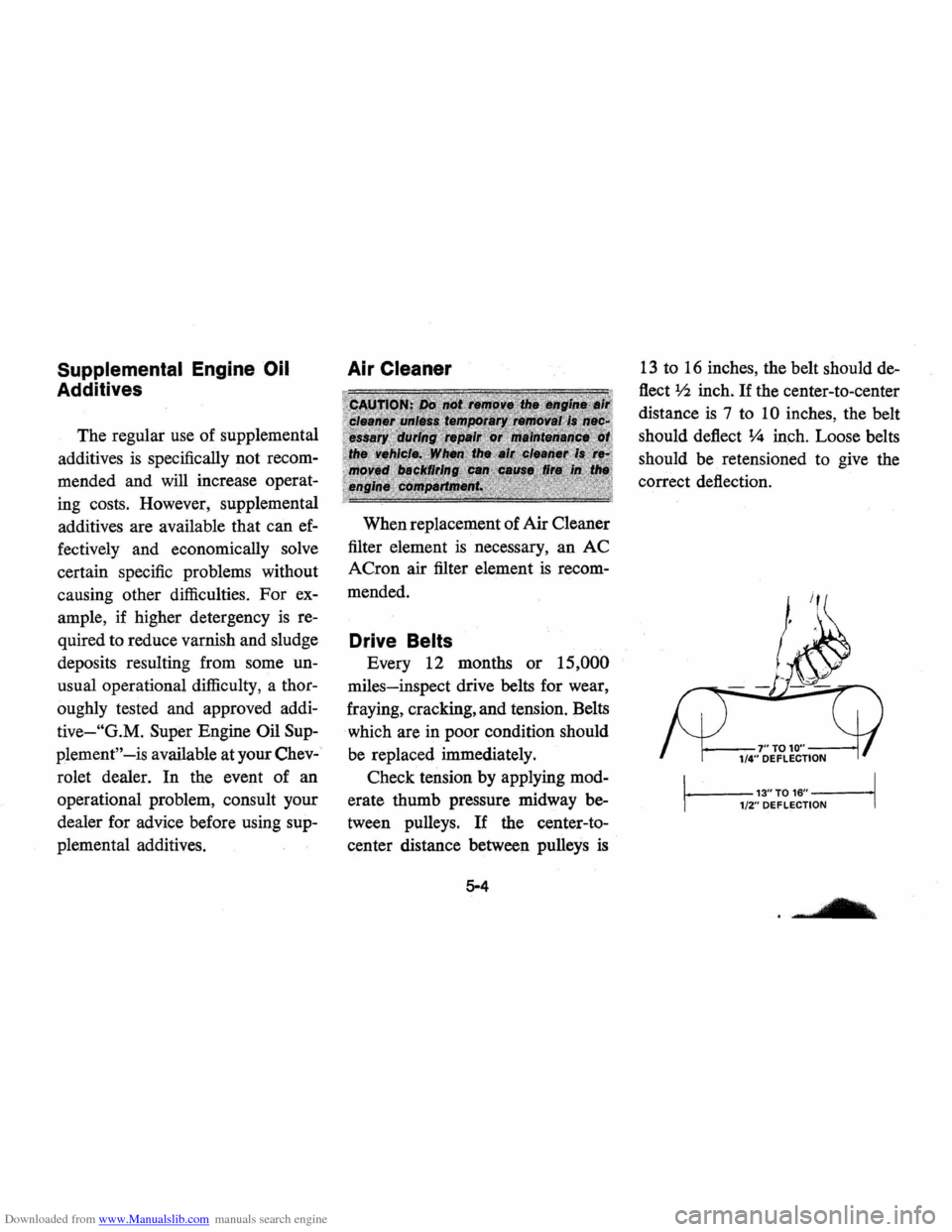
Downloaded from www.Manualslib.com manuals search engine Supplemental Engine Oil
Additives
The regular use of supplemental
additives
is specifically not recom
mended and will increase operat
ing costs. However, supplemental
additives are available that can
ef
fectively and economically solve
certain specific problems without
causing other difficulties.
For ex
ample, if higher detergency is re
quired to reduce varnish and sludge
deposits resulting from some un
usual operational difficulty, a thor
oughly tested and approved addi
tive-"G.M. Super Engine Oil Sup
plement" -is available at your Chev
rolet dealer.
In the event of an
operational problem, consult your
dealer for advice before using sup
plemental additives.
Air Cleaner
When replacement of Air Cleaner
filter element
is necessary, an AC
ACron air filter element
is recom
mended.
Drive Belts
Every 12 months or 15,000
miles-inspect drive belts for wear,
fraying, cracking, and tension. Belts
which are in
pOQr condition should
be replaced immediately.
Check tension by applying mod
erate thumb pressUre midway be
tween pulleys.
If the center-to
center distance between pulleys
is
5-4
13 to 16 inches, the belt should de
flect
'h inch. If the center-to-center
distance
is 7 to 10 inches, the belt
should deflect
~ inch. Loose belts
should be retensioned to give the
correct deflection.
1----7'· TO 10" --~ 1/4" DEFLECTION
I· 13" TO 16" I ~"DEFLECTI~
Page 65 of 87
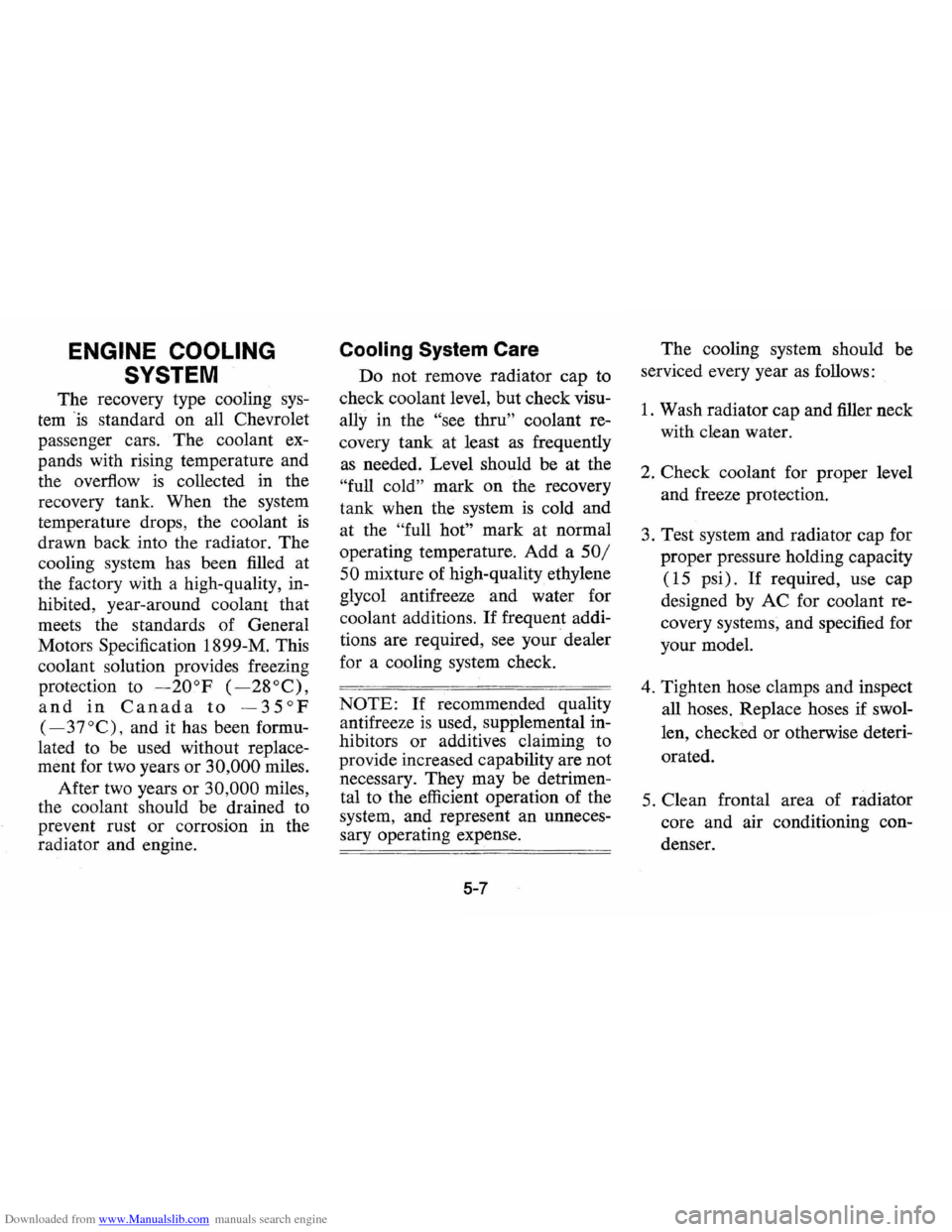
Downloaded from www.Manualslib.com manuals search engine ENGINE COOLING
SYSTEM
The recovery type cooling sys
tem 'is standard on all Chevrolet
passenger cars. The coolant ex
pands with rising temperature and
the overflow
is collected in the
recovery tank. When the system
temperature drops, the coolant
is
drawn back into the radiator. The
cooling system has been filled at
the factory with a high -quality, in
hibited ,
year-around coolant that
meets the standards of General
Motor s Specification 1899-M. This
coolant solution provides freezing
protection to
-20oP (- 28 °C),
and in Canada to -35°P
(-37°C), and it has been formu
lated to be used without replace
ment for two years
or 30,000 miles.
After two years or
30,000 miles,
the coolant should be drained to
prevent rust
or corrosion in the
radiator and engine.
Cooling System Care
Do not remove radiator cap to
check coolant level, but check visu
ally in the
"see thru" coolant re
covery tank at
least as frequently
as needed. Level should be at the
"full cold" mark on the recovery
tank when the system
is cold and
at the
"full hot" mark at normal
operating temperature.
Add a 50/
50
mixture of high-quality ethylene
glycol antifreeze and water for
coolant additions.
If frequent addi
tions are required, see
your' dealer
for a cooling system check.
NOTE: If recommended quality
antifreeze
is used, supplemental in
hibitors or additives claiming to
provide increased capability are not
necessary. They may be detrimen
tal to the efficient operation of the
system, and represent an unneces
sary operating expense.
5-7
The cooling system should be
serviced every year as follows:
1. Wash radiator cap and filler neck
with clean water.
2. Check coolant for proper level
and freeze protection.
3 . Test system and radiator cap for
proper pressure holding capacity
(15 psi). If required, use cap
designed by
AC for coolant re
covery systems, and specified for
your model.
4. Tighten hose clamps and inspect
all hoses. Replace hoses if swol
len, checked or otherwise deteri
orated.
5 . Clean frontal area of radiator
core and air conditioning con
denser.
Page 70 of 87
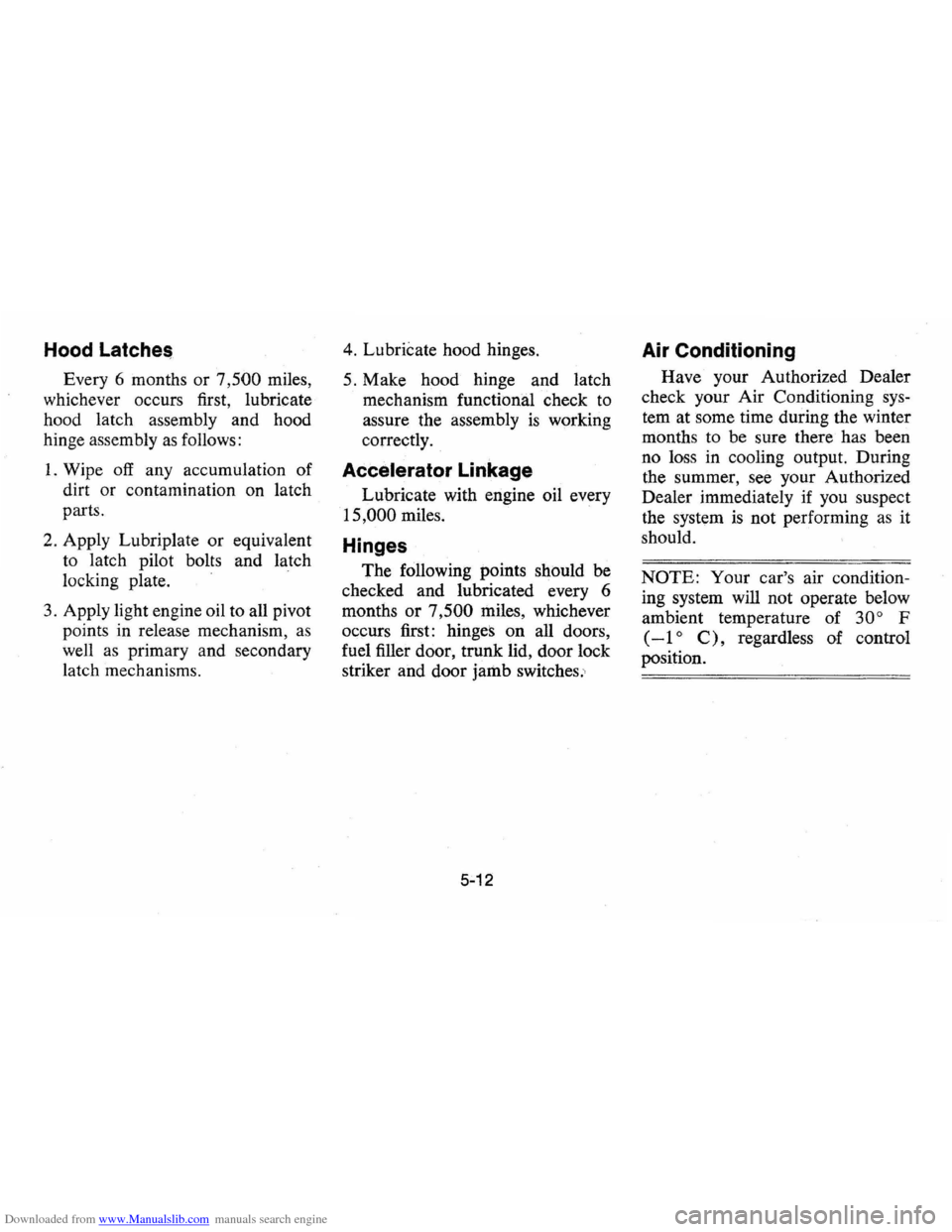
Downloaded from www.Manualslib.com manuals search engine Hood Latche$
Every 6 months or 7,500 miles,
whichever occurs first, lubricate
hood latch assembly and hood
hinge assembly
as follows:
1. Wipe off any accumulation of
dirt or contamination on latch
parts.
2 . Apply Lubriplate or equivalent
to latch pilot bolts and latch
locking plate.
.
3. Apply light engine oil to all pivot
points in release mechanism,
as
well as primary and secondary
latch mechanisms.
4. Lubricate hood hinges.
5. Make hood hinge and latch
mechanism functional check
to
assure the assembly is working
correctly .
Accelerator Linkage
Lubricate with engine oil every
15,000 miles.
Hinges
The following points should be
checked and lubricated every 6
months or
7,500 miles, whichever
occurs first:
hingeS on all doors,
fuel filler door, trunk lid, door lock
striker and door
jamb switches. '
5-12
Air Conditioning
Have your Authorized Dealer
check your Air Conditioning
sys
tem at some time during the winter
months to be sure there has been
no loss in cooling output. During
the summer , see your Authorized
Dealer immediately if you suspect
the system
is not performing as it
should.
NOTE: Your car's air condition
ing system will not operate below
ambient temperature of
300 F
( -1 0 C) , regardless of control
position.
Page 76 of 87

Downloaded from www.Manualslib.com manuals search engine a~~~
DO NOT DO NOT
w~ ~"" "." !d'"
REPAIR AREA RADIAL TIRES
Tire Repair
Temporary repair patches or any
repairs made from the outside of
the tire are not recommended ex
cept in emergencies. Such "stop
gap"
devices as plugs and aerosol
type sealants are not recommended
for more than
100 miles of driving
at speeds not over
50 mph. A per
manent vulcanized repair (plug
and patch) applied from inside the
tire should be made
as soon as pos
sible. The installation of an inner
tube in a damaged tubeless tire
is not a recommended repair pro
cedure.
If an air loss occurs while
driving, do not attempt
to drive on
the deflated tire more than neces
sary to stop safely. Driving even a
short distance on a deflated tire can
damage a tire beyond repair.
The tire industry recommends
that punctures
on passenger car type
radial tires up to
%" diameter can
usually be repaired if they occur
5-18
between the major outer tread
grooves.
Traction and Snow Tires
A decrease in driving, cornering,
and braking traction occurs when
water , snow, ice, gravel,
or other
material
is on on the road surface.
Driving practices and vehicle speed
should be adjusted to the road
conditions. When driving on wet or slushy
roads , it
is possible for a wedge of
water to build up between the tire
and road surface. This phenome
non, known
as hydroplaning, may
cause partial or complete loss of
traction, which adversely affects
vehicle
control and stopping
ability. To reduce the possibility of
traction loss, the following pre
cautions should
be observed:
1 .
Slow down during rainstorms or
when
roads are slushy.
2. Slow down if road has standing
water or
pUddles.